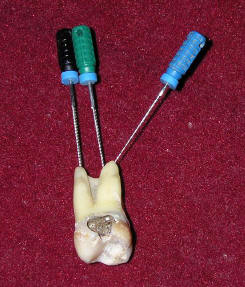Introduction: The Role of RCT
As dentists we want to give best service to our patients. When he needs a root canal we want to give him the best. The best is to rid the canal of all debris and bacteria and then obturate it so that it can give him years of service. At the same time we want the procedure to be done in a smooth fashion without much stress and without tension of instrument or treatment failure.
What is the GOAL of RCT ?
-
Shaping the canal to receive proper obturation to achieve hermetic seal. This is done by use of instruments.
-
Cleaning the canal to make it bacteria free. This is done by instrumentation and irrigation. Some areas of canal are so small that irrigants can not reach unless those areas are enlarged at least to size 30.
-
Avoid excessive destruction of coronal portion by using large tapered instruments so that after restoration tooth can serve in mouth without getting fractured.
First two of these goals are crucial for the apical third because if any bacteria are left in this area apical periodontitis will recur leading to treatment failure. (or you will land up doing many apicoectomies and retrograde fillings to get apical seal )
New instruments and materials are being introduced faster than you can manage to comfortably understand and master. When you approach a new technique/ material its very important to have a clear concept of what you want to achieve. Multitude of scientific studies emphasize the fact that a cleaner canal dictates the prognosis of a root canal treated tooth. And we know that apical third is the most critical area from this stand point.
Preparing of Endodontics Access is very crucial. Straightline access is the key to perform successful and quality endodontic work. Without learning proper straightline access you will be frustrated and there will be excessive instrument separation. To read more on endodontics access CLICK HERE
Many of popular rotary endo techniques have you finish the apex to size 25 or 30, you can not do more with big taper instruments. HERE is simple test, when you extract teeth -take K file and insert from the apex, NOTE the biggest file that fits the apical foramen without friction. NOW this is UNPREPARED size of the apical foramen. You will be shocked to see in most instances it is larger than 30, goes upto 50-60. Here is a pic to help you do it.

"In recent years, the trend in endodontics has been towards simplifying and speeding up the instrumentation and obturation of canals. Dental companies have concentrated their marketing efforts on one message: it can now take fewer files, less time and less effort to completely instrument canals. In fact, some of the newer and more popular rotary nickel titanium (NiTi) files do not even come in sizes larger than 50. Unfortunately, as is often the case, technology and clever marketing are dictating treatment instead of science." So before you go for something new, examine it critically and see if it will help you achieve your goals.
No natural canal is perfectly round when examined in cross-section. Most canals are naturally oval and the file that is used should be large enough to debride the canal. Anything less will leave behind undesirable tissue. For example, if the natural apical canal size of a maxillary lateral incisor is about 0.5 mm (equivalent to a size 50 file), then the master file size should be just correspondingly larger.
Canal curvatures are a rule rather than exception. This aspect poses further challenge. Proper selection/choice of hand/rotary instruments is crucial to the success of your root canal treatment, want to learn ? come to us
Dentists today are more confused than ever before, see the post on the link http://health.groups.yahoo.com/group/idon/message/374, it is produced here for your ready reference:
"I am very confused of the
different root canal preparation techniques. I have heard of many techniques and
trying to understand the basic concept of main techniques. I'm confused in "
Modified crown down technique", crown down technique, step down technique,
modified double flare technique, double flare technique. I have gone through the
text books of Principles of endodontics by Walton, Endodontic Procedures by
Franklin Weine, Pathways of pulp by Cohen,Burns.
Please guide me as I'm now very confused about the techniques used. Which
technique now a days is more acceptable theoretically and practically and why?"
References:
Card S, Trope M, Sigurdsson A, Orstavik D. The effectiveness of increased apical enlargement in reducing intracanal bacteria. J Endod 2002; 28(1):779–83.
Tweet